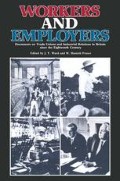Abstract
The repeal of the Combination Acts brought into the open many of the trade societies which had quietly persisted through the years of illegality. New societies burgeoned, and strikes were widespread. Some observers, such as the leaders of the Glasgow Mechanics’ Institute, hoped that repeal would usher in an era of industrial peace (1), while to Thomas Hodgskin (1783–1869) and other anti-capitalist economists at the London Mechanics’ Institute it offered the possibility of a war against capital (2). There was a strong assertion of new-found power on the part of some unions (3), and the Government was undoubtedly taken aback by the extent of unionism. As a result, the Combination Laws Repeal Act of 1824 was amended, and the Combination of Workmen Act of 1825 more narrowly defined the right to combine (4). Protection from common-law charges of criminal conspiracy which the 1824 Act had granted were removed and for nearly half a century the position of unions was legally circumscribed in fairly narrow terms.
Preview
Unable to display preview. Download preview PDF.
Editor information
Copyright information
© 1980 Macmillan Publishers Limited
About this chapter
Cite this chapter
Ward, J.T., Fraser, W.H. (1980). The Turbulent Years, 1825–42. In: Ward, J.T., Fraser, W.H. (eds) Workers and Employers. Palgrave, London. https://doi.org/10.1007/978-1-349-16277-2_2
Download citation
DOI: https://doi.org/10.1007/978-1-349-16277-2_2
Publisher Name: Palgrave, London
Print ISBN: 978-0-333-15413-7
Online ISBN: 978-1-349-16277-2
eBook Packages: Palgrave Business & Management CollectionBusiness and Management (R0)

